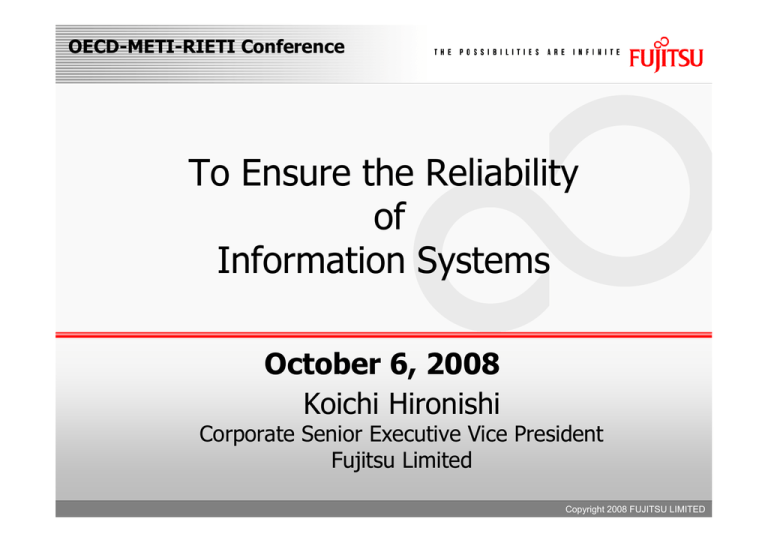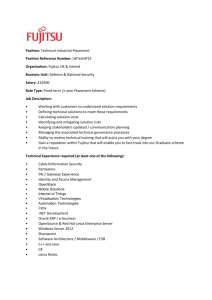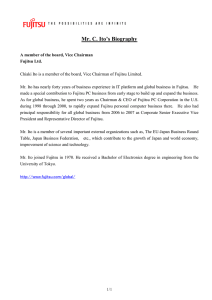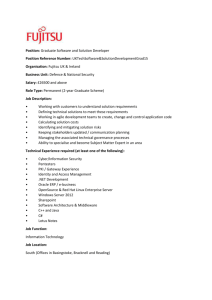To Ensure the Reliability of Information Systems October 6, 2008
advertisement

OECD-METI-RIETI Conference To Ensure the Reliability of Information Systems October 6, 2008 Koichi Hironishi Corporate Senior Executive Vice President Fujitsu Limited Copyright 2008 FUJITSU LIMITED Agenda zWhat is the reliability of information systems? zWhat is needed to ensure reliability? zFujitsu’ s approach to ensure reliability zWrap up ~To Ensure Reliability 1 Copyright 2008 FUJITSU LIMITED What is the reliability of Information Systems? From a User’s point of view... To realize the expected role of the information system throughout its lifecycle Both users and vendors must mutually understand the role of the system and make efforts to realize it. 2 Copyright 2008 FUJITSU LIMITED What is needed to ensure reliability? Engineering cannot be the only solution to ensure reliability. Users and Vendors must understand the requirements correctly and Vendors develop the function with quality based on the requirements. Key Point: Elimination of ambiguity and visualization of the requirements 3 Copyright 2008 FUJITSU LIMITED Fujitsu’ s approach to ensure reliability To understand the requirements correctly Fujitsu develops common views (measures) collaborating with other vendors and users. To develop the function with quality based on the requirements, Fujitsu is using the approach of “Four Innovations” to improve system development. 4 Copyright 2008 FUJITSU LIMITED Developing common views (measures) collaborating with other vendors and users 5 Copyright 2007 FUJITSU LIMITED Fujitsu’ s approach to ensure reliability 1 Common framework for Software Lifecycle Process 2007 (SLCP) (2006~) 2 Ensuring the quality with Top Executives (2004~) 3 Customers’ view study group (2006 - ) 4 The Grades standards for Non-functional requirements (2007~) 6 Copyright 2008 FUJITSU LIMITED Fujitsu’ s approach to ensure reliability Developing common views (measures) 1 Common framework for Software Lifecycle Process 2007 (SLCP) (2006~) Common measures for planning, development, operation and maintenance of Information Systems to help mutual understanding of each work item through the life cycle process. 2 Ensuring the quality with Top Executives (2004~) Recommendation on involvement of Top Executives of users to clarify the role sharing between vendors and users in the development of Information Systems. 7 Copyright 2008 FUJITSU LIMITED Developing the common views (measures) 3 Customers’ view study group (2006 -) Pursuing how to describe external specification in an easyto-understand way for users and how to build consensus in business application development. 4 The Grades standards for Non-functional requirements (2007~) Visualization of Non-functional requirements such as performance, operability, security and formulation of the guidelines for user-friendly methods for consensus building between users and vendors. 8 Copyright 2008 FUJITSU LIMITED Fujitsu’ s approach to ensure reliability 1 Common framework for Software Lifecycle Process 2007 (SLCP) (2006~) 2 Ensuring the quality with Top Executives (2004~) 3 Customers’ view study group (2006 -) 4 The Grades standards for Non-functional requirements (2007~) 9 Copyright 2008 FUJITSU LIMITED SLCP-Japan Common Framework 2007 Revised from SLCP-JCF ‘98 Agreement Processes Acquisition Processes ③ Supply Processes Contract Change Mgmt Processes Primary Processes ① Planning Processes ② Requirements Building/Developing Process Development Processes Organizational Processes Maintenance Processes Software Support Processes Operation Processes Software Reuse Processes … ④ System Audit Procs added and tailored in JCF Copy right all reserved in Japan National Board of SC7/WG7 & IPA Software Engineering Center 2008 Copyright 2008 FUJITSU LIMITED 10 Fujitsu’ s approach to ensure reliability 1 Common frame for Software Lifecycle Process 2007 (SLCP) (2006~) 2 Ensuring the quality with Top Executives (2004~) 3 Customers’ view study group (2006 -) 4 The Grades standards for Non-functional requirements (2007~) 11 Copyright 2008 FUJITSU LIMITED Planning Processes & Requirements Building/Developing Process Appendix: Seventeen Principles 1. Expectations of users and venders often differ 2. Any decision consists of agreement and approval 3. Never postpone decisions crucial to the project 4. Never proceed to the next process without agreement by stakeholders 5. Multi stage contract decreases risks for both parties 6. System development costs you much more than software development does 7. Emphasize system life cycle cost 8. The objective of the project is meaningful only when everybody knows it 9. Requirements are attributed to users after all 10. Requirements definition is the baseline of development 11. Good requirements definition describes new business system in detail 12. Never implemented are unexpressed requirements 13. Qualitative expressions are interpreted in a developers favorite way 14. No such requirement as ‘Just same as present’ 15. An ideal business system will never be realized 16. Functional requirements diverge, cost and schedule converge them 17. Users are accountable for requirements definition *for each principle, disciplines in action are described for both user and supplier Copy right all reserved in Japan National Board of SC7/WG7 & IPA Software Engineering Center 2008 Copyright 2008 FUJITSU LIMITED 12 Fujitsu’ s approach to ensure reliability 1 Common frame for Software Lifecycle Process 2007 (SLCP) (2006~) 2 Ensuring the quality with Top Executives (2004~) 3 Customers’ view study group (2006 - ) 4 The Grades standards for Non-functional requirements (2007~) 13 Copyright 2008 FUJITSU LIMITED Customers’ view study group [Area targeted by Customers' view study group] "Study group for customers' view on requirements specification based on a practical approach" (called "Customers' view study group" hereinafter) targeted the "External design" phase because it is the phase where developers have lots of contact with customers and customers are involved until program production. Then the group targeted three technology areas: "Screen", "System behavior” and “Data model“. [ Target Phase ] [ Target Technology Area ] Direction of systematization Screen transition/definition Plan of systematization Business logic (Specification of detail processing) Requirements definition System design System development Testing External design Business process Internal design Screen System behavior (Specification of business operation flow and procedure) Data model (Specification of database) Data model (Excerpt from the public presentation by Customers’ view study group on March 18, 2008) 14 Copyright 2008 2007 FUJITSU LIMITED Customers’ view study group Customers’ view guideline (Screen design edition) Introducing , as a tip, ingenuity and things to note either to prevent misunderstanding or to find perception gap. Chapter title The points in description example are further explained in speech balloon. Description example, showing both undesirable and desirable examples which actually appeared in design documents. This example shows one of the tips when drawing screen transition diagrams. Explanation of description example (Excerpt from the public presentation by Customers’ view study group on September 18, 2007) 15 Copyright 2008 FUJITSU LIMITED Fujitsu’ s approach to ensure reliability 1 Common frame for Software Lifecycle Process 2007 (SLCP) (2006~) 2 Ensuring the quality with Top Executives (2004~) 3 Customers’ view study group (2006 -) 4 The Grades standards for Non-functional requirements (2007~) 16 Copyright 2008 FUJITSU LIMITED The Grades standards for Non-functional requirements Why the Grades (levels of) standards are needed… Functional Requirements Functional and Non-functional requirements on Information Systems Specific Function ① Requirement on availability Requirement on capability Recovery from system down within 3 hours… Response time within 3 seconds… Sharing the sales information on the system. Availability Safety Reliability Specific Function ② Maintenance Inventory management linked to ordering information Business Continuity Emergency Management Various Nonfunctional requirements Capability Operability Transitivity Usability Security Challenges for Venders/Users on Non-functional Requirements It It is is difficult difficult to to clarify clarify Non-functional Non-functional requirements requirements at at early early stage stage of of planning planning As As requirements requirements or or specifications specifications are are still still vague vague in in the the upper upper process process of of the the planning, planning, venders and users cannot have mutual understanding on Non-functional requirements. venders and users cannot have mutual understanding on Non-functional requirements. 17 Copyright 2007 FUJITSU LIMITED The Grades standards for Non-functional requirements Image of the Grades standards Item Grades Chart Each item of the requirements: Classification of expected features Level 1 Level 2 Level 3 Capability Operability Emergency response e.g. Emergency response ① ② Protect data as restorable format Cost and Development period ; Low and Short Ensure business continuity in case of failure in each equipment ③ Ensure business continuity in case of larger disruption Grades (Levels) List options for each requirement Cost and Development Cost and Development period ; high and Long period ; Middle Help mutual understanding on requirements by indicating options for each requirement. We need the system performance in an emergency... The impact of emergency on business and recovery level will be like this... Determine the level of emergency response Discussion Discussion and and assumption assumption on on emergency emergency response response by by vendors vendors and and users. users. Levels Levelschart chart 18 Copyright 2007 FUJITSU LIMITED The Grades standards for Non-functional requirements Schedule 2007 First half Primary Primary discussion discussion by by voluntary voluntary vendors vendors Collect Collect examples examples and and review representation review representation Start Pick out Nonfunctional requirements 2009 2008 Second half First half Draft Draft Non-functional Non-functional Grades Grades standards standards Review Review draft draft standards standards by users and by users and promote promote dissemination dissemination through through industry group industry group or or publication publication Interim output Review by Users Aggregate knowledge of venders Draft Grades Standards Aim to become De-facto standard! How to utilize the Grades standards ○Through industry-wide ○In each vendor ・Build consensus on Non-functional ・Reflect the standards in requirements between vendors and users. requirements definition documents. 19 Copyright 2007 FUJITSU LIMITED Fujitsu’s practice: “Four Innovations” in System Development 20 Copyright 2007 FUJITSU LIMITED “Four Innovations” in System Development Production Design zGuidelines for RDDs * zInternal audit of RDDs zIndustry-wide initiatives for improving RDDs zCultivating Business Architects System architecture zTemplates for system development zIndustrialization zOffshore development Maintenance zService templates Building/testing Operation/ maintenance Way of working for system engineers z TPS-based HR development, small group activities *RDD: Requirement Definition Document 21 Copyright 2008 FUJITSU LIMITED Innovation in design Improvement of the quality of planning and mandatory review by a third party within Fujitsu z Guidelines for RDDs* z Internal Audit of RDDs z Diagnosis of external specification 関連するSEC書籍 共通フレーム 共通フレーム2007 2007 (SLCP-JCF2007) (SLCP-JCF2007) Human development zCultivate Business Architects who support planning, requirements building and developing processes. *RDD: Requirement Definition Document 22 Copyright 2008 FUJITSU LIMITED Innovation in design Mandatory review of the RDDs* of system integration exceeding certain size by third party within Fujitsu Process of requirement definition Customer Process of external design Reflect requirements into external design RDDs External design documents Fujitsu Internal audit of RDDs Diagnosis of external design Recommendation *RDD: Requirement Definition Document Feed back 23 Copyright 2008 FUJITSU LIMITED An example of Internal audit of RDDs Aggregate AggregateCheck Check Consistency ConsistencyCheck Check Environment In the operation requirements Non-functional requirement B Non-functional requirement A Job transaction Between operations and Non-functional requirements Between operations and Functional requirements System performance Data Interaction Environment Non-functional requirement B Job transaction System performance Non-functional requirement A In Nonfunctional requirements Interface Compatibility CompatibilityCheck Check In Functional requirements Between Functional and Non-functional requirements 24 Interface Data Interaction Copyright 2008 FUJITSU LIMITED Wrap up ~To Ensure Reliability 25 Copyright 2007 FUJITSU LIMITED To Ensure Reliability Improvement of the quality from two aspects Adopt industrial standards Industrial activity Internal practice Provide internal Know-how Clarification of requirements by Common Views (Measures) Improvement of technologies by “Four Innovations” Reliability of Information Systems 26 Copyright 2007 2008 FUJITSU LIMITED 27 29 Copyright 2007 2008 FUJITSU LIMITED


